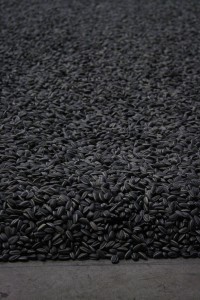The Tate Modern is the national gallery of international modern art located in the heart of London’s South Bank. Created in 2000 from an abandoned power station, his museum is one of four Tate museums. The collection in the Tate Modern comprised of art from the year 1900 and beyond. The museum is home to such famous artists Matisse, Picasso, Dali, and Pollock. The Modern’s displays are housed in four distinct wings, Surrealism, Minimalism, Post-war innovations, and Cubism, Futurism, and Vorticism, which are arranged together in one gallery. Surrounding these main wings are pieces of present works that seek to respond to or challenge the movements displayed by the main wings.
While I visited the Tate Modern one particular work of art that struck me was Ai Weiwei’s Sunflower Seeds This installation i s a part of the annual Unilever Series, which commissions an artist to create a piece of art specifically for the Tate Modern’s Turbine Hall. At first glance one merely sees a massive rectangular shape of Sunflower Seeds that people are no longer allowed to walk on. In all honesty, when I first saw the massive rectangular room of sunflower seeds, without any external reference, I found myself questioning why this is considered art, and why was it allowed to take up such a great deal of space? However, after reading Ai Weiwei’s explanation of the exhibit, Iv felt completely different and found myself fascinated by Sunflower Seeds.
The seeds look very real, but were actually made out of porcelain and skillfully hand painted by approximately 1600 people in the Chinese city of Jingdezhen. Even though all of the seeds appear to have the exact same characteristics, each individual seed holds its own unique qualities and contains its own story. All of these unique individuals, together, comprise a total work that presents 1 00 million sunflower seeds as a single unique surface.
In his explanation of the piece Ai Weiwei stated, “Your own acts and behaviour tell the world who you are and at the same time what kind of society you think it should be.” This quote resonates with our in-class discussion this past Friday about individual identity and how that influences, or rejects, the creation of a national identity. TTThis is particularly relevant when discussing the United Kingdom because it is, essentially, one country that is comprised of four different countries: England, Northern Ireland, Scotland, and Wales. Each one of the four individual countries within the nation-state holds their own distinct cultural values and ideas of what the national identity, as presented to the rest of the world, should be comprised of. Therefore, to make a national identity, some level of agreement must be reached amongst the people, in order for there to be one representative identity for the rest of the world. However, this is nearly impossible to do without marginalizing certain groups of people. This compromise of individual and whole, in particular, is why I found Sunflower Seeds to be such an impressive piece of art. It seemed as if the seeds within the Turbine Hall had somehow, temporarily, found a way to strike a balance between the two.
Photo by Bernadette Egger
Works Referenced
About the Tate Modern. 12 Jan. 2011. <http://www.tate.org.uk/modern/about.htm>
